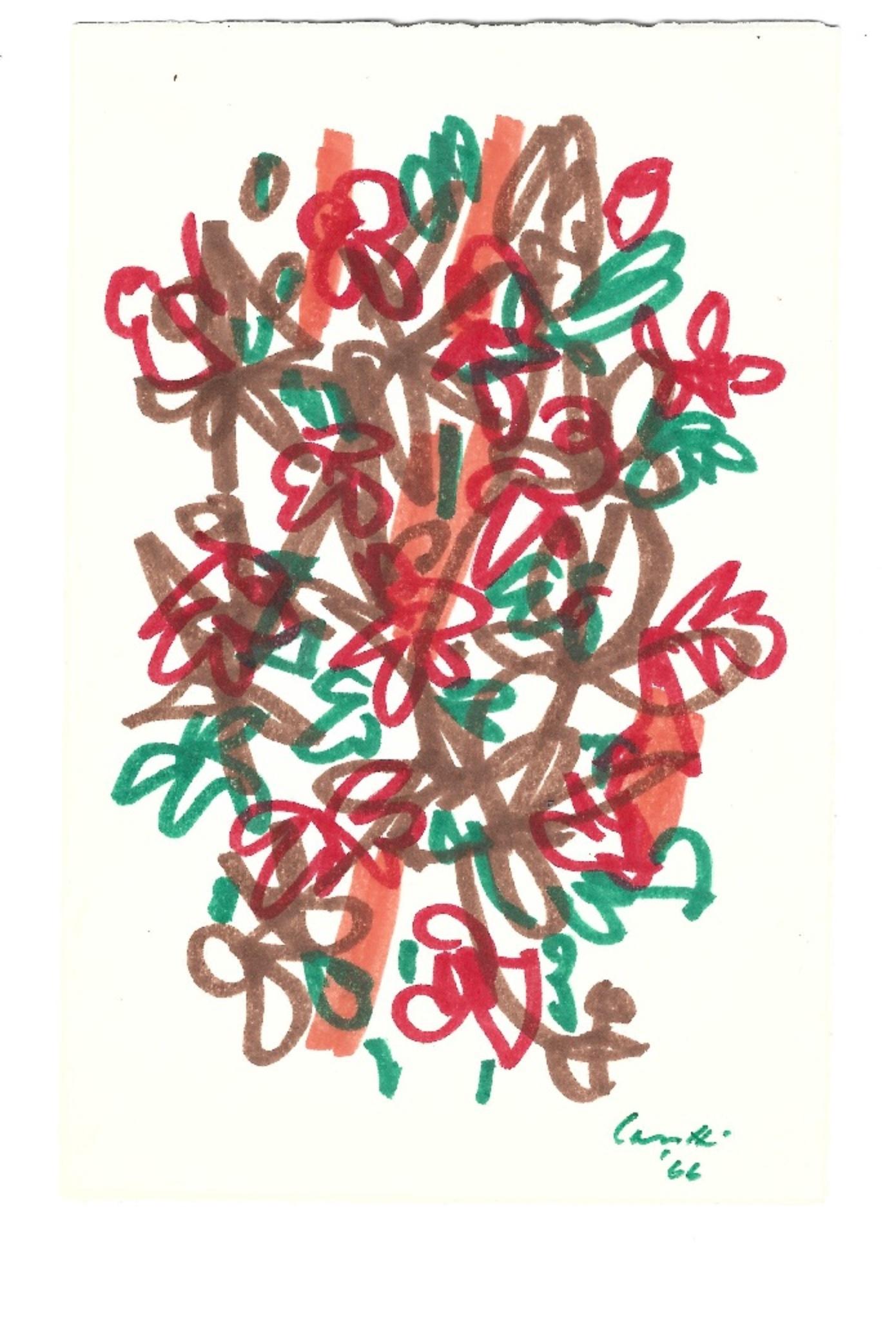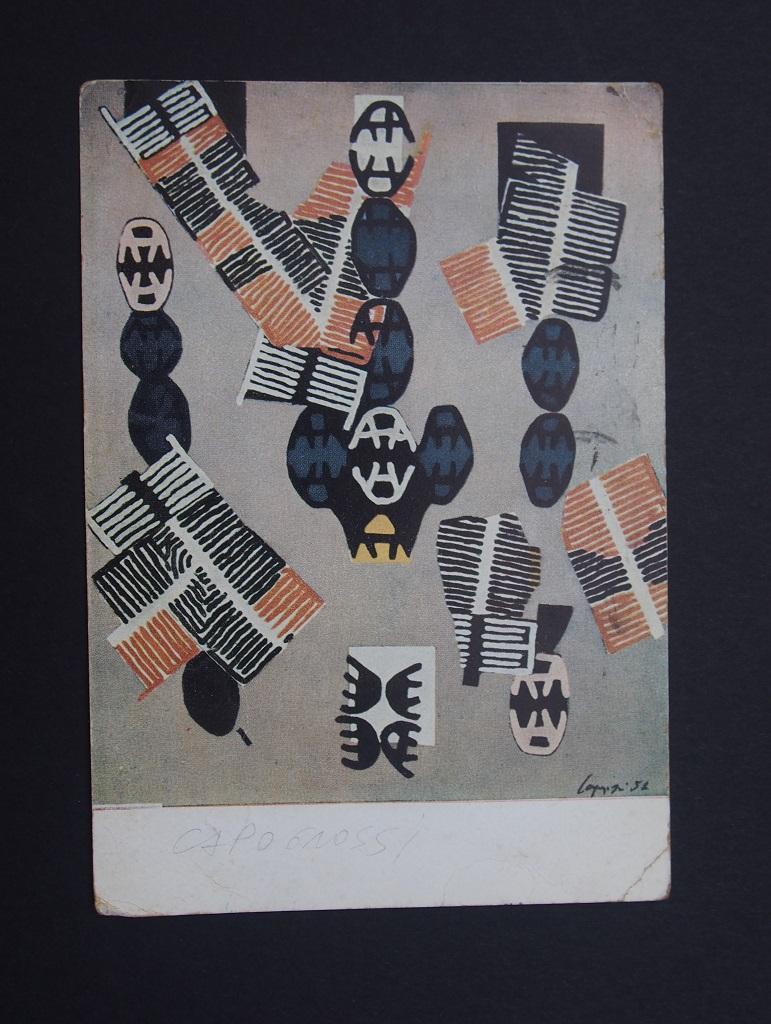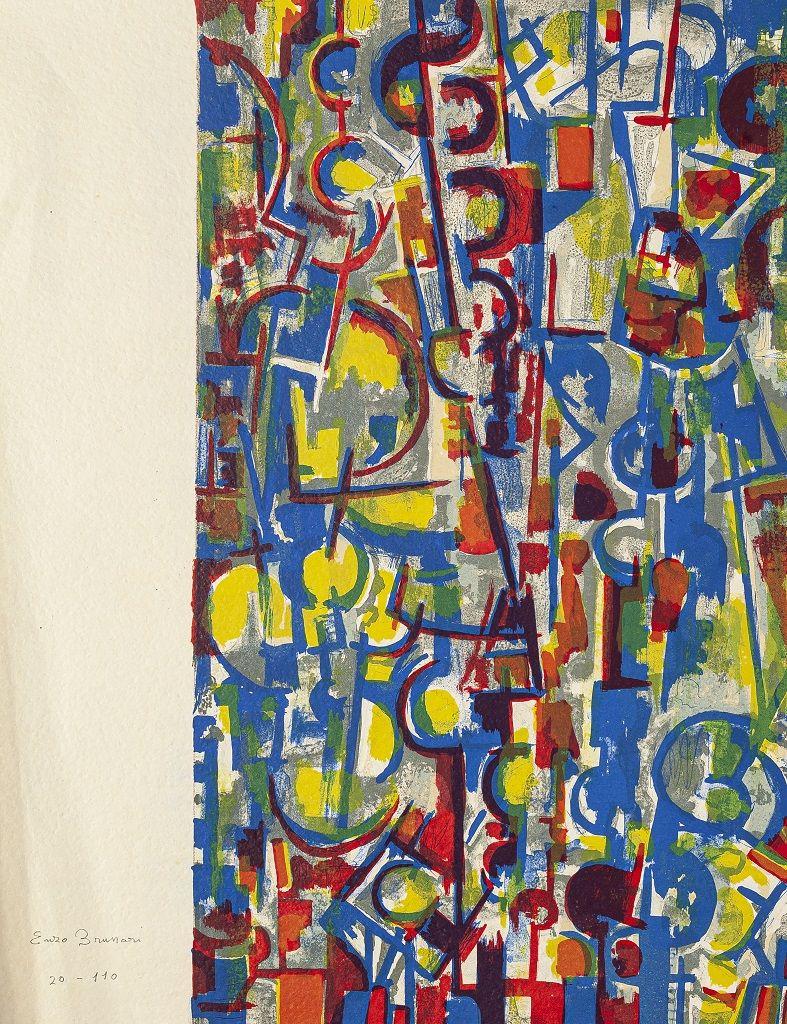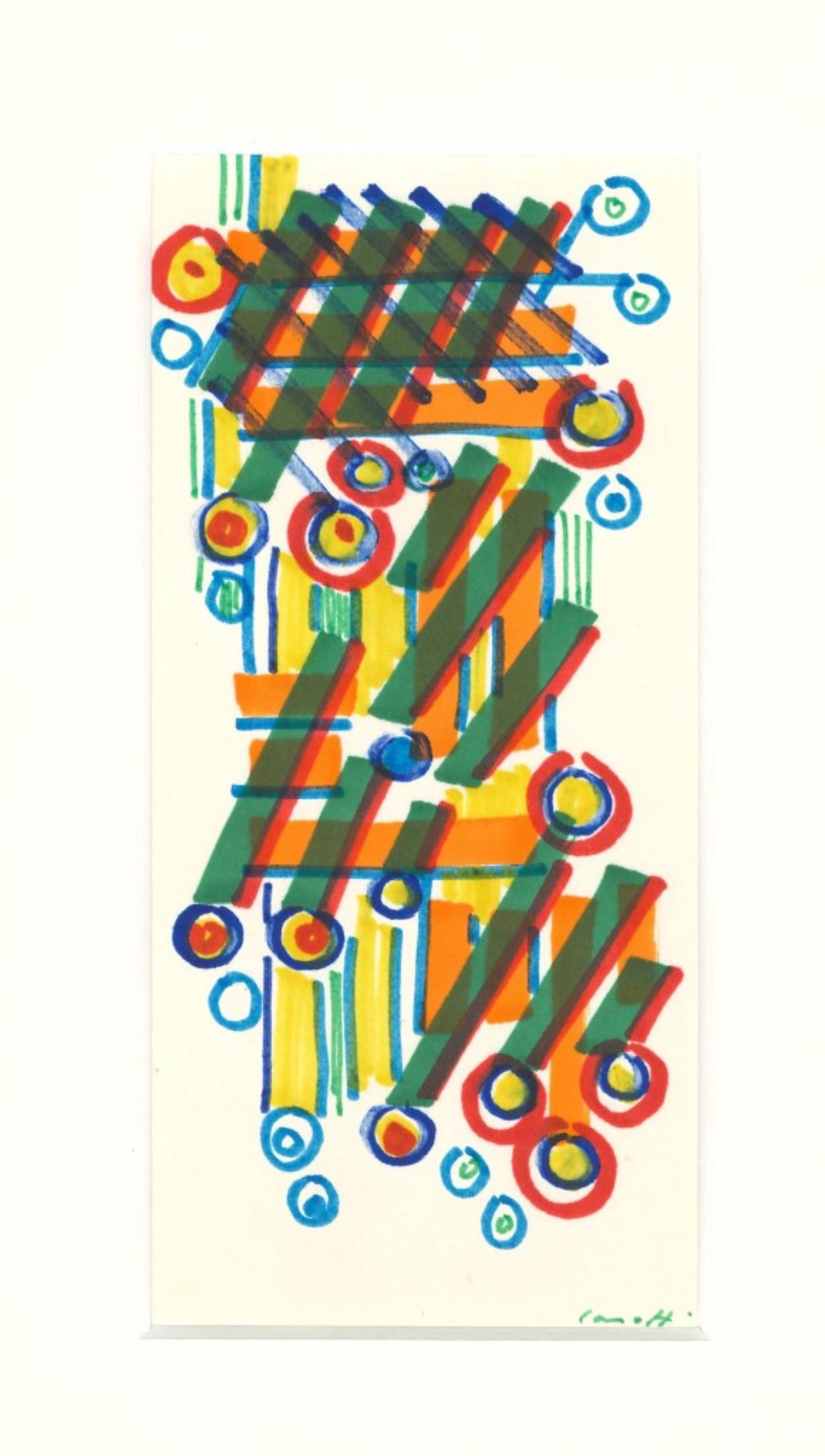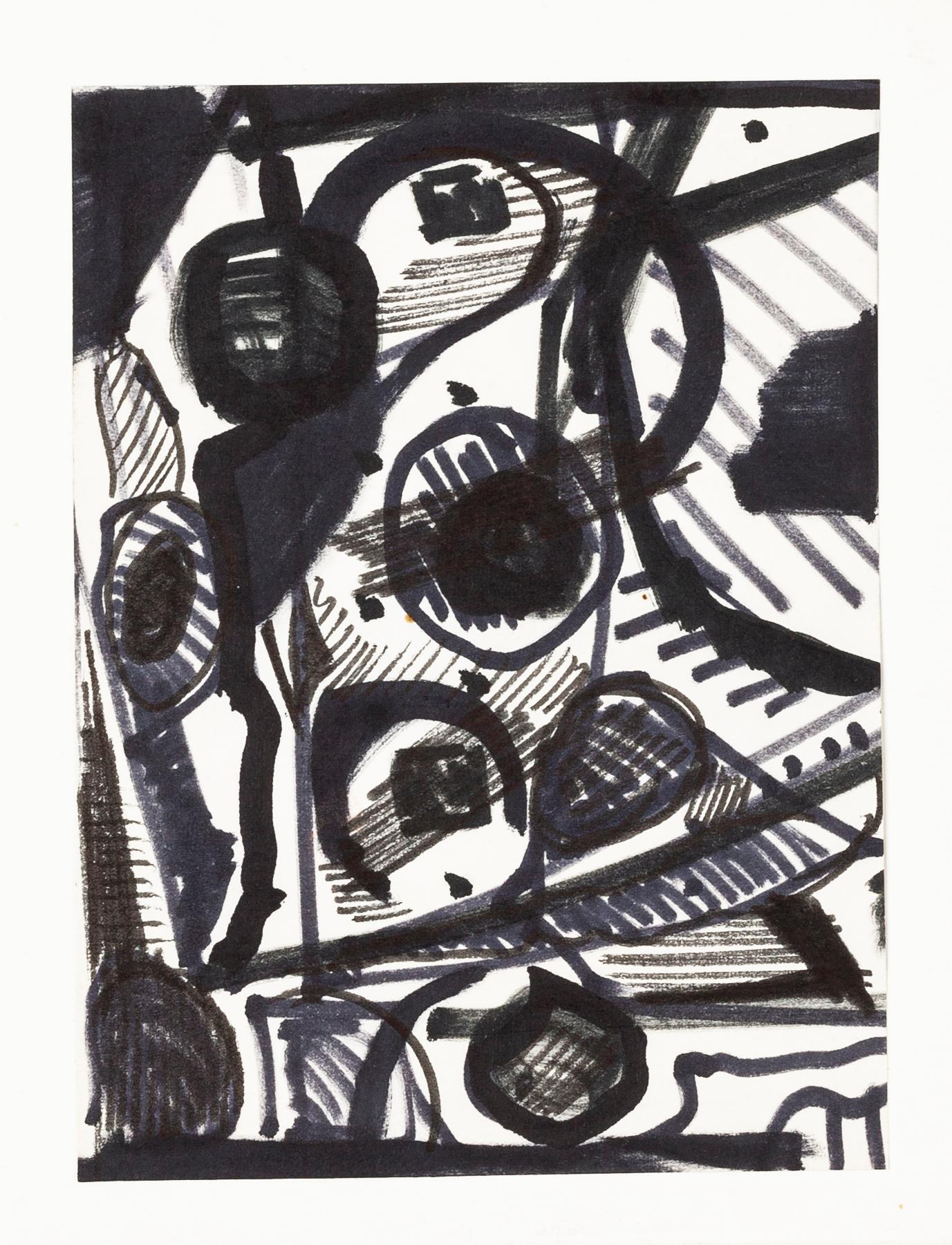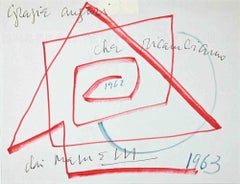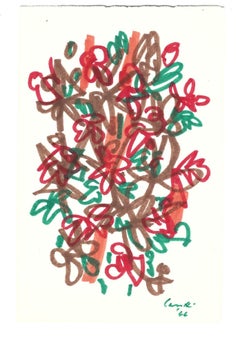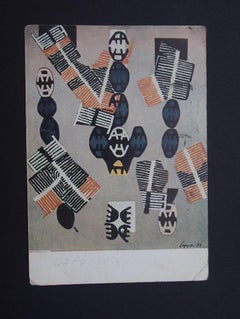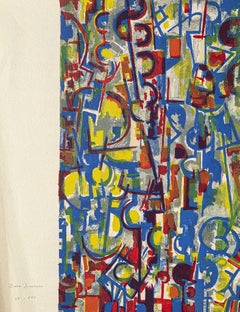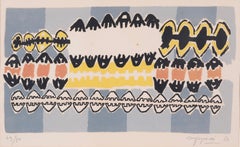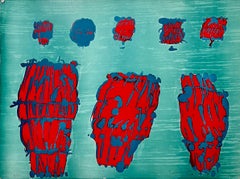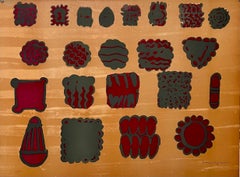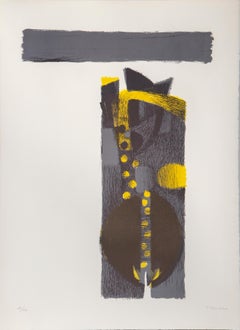Items Similar to Christmast Card '65 - Drawing by Umberto Maria Casotti - 1965
Want more images or videos?
Request additional images or videos from the seller
1 of 2
Umberto Maria CasottiChristmast Card '65 - Drawing by Umberto Maria Casotti - 19651965
1965
$407.37
£303.20
€340
CA$557.99
A$620.61
CHF 324.06
MX$7,552.17
NOK 4,138.79
SEK 3,881.45
DKK 2,588.30
Shipping
Retrieving quote...The 1stDibs Promise:
Authenticity Guarantee,
Money-Back Guarantee,
24-Hour Cancellation
About the Item
Christmas Card '65 is an artwork realized by Umberto Maria Casotti in 1965.
Watercolor Drawing with and hand-written inscription.
Penmarks and pen on paper.
Mint conditions.
Christmas and greeting card realized by the artist Umberto Maria Casotti (Taranto, 1919 - Rome, 2000).
Umberto Maria Casotti was an Italian painter and artist that realized several graphic works with serigraphic technique accompanied with the writings of Nello Ponente, Cesare Vivaldi and G. C. Argan.
- Creator:Umberto Maria Casotti
- Creation Year:1965
- Dimensions:Height: 7.68 in (19.5 cm)Width: 13.19 in (33.5 cm)Depth: 0.04 in (1 mm)
- Medium:
- Movement & Style:
- Period:
- Framing:Framing Options Available
- Condition:Insurance may be requested by customers as additional service, contact us for more information.
- Gallery Location:Roma, IT
- Reference Number:Seller: T-1494381stDibs: LU650314658442
About the Seller
4.9
Platinum Seller
Premium sellers with a 4.7+ rating and 24-hour response times
1stDibs seller since 2017
7,617 sales on 1stDibs
Typical response time: 3 hours
- ShippingRetrieving quote...Shipping from: Roma, Italy
- Return Policy
Authenticity Guarantee
In the unlikely event there’s an issue with an item’s authenticity, contact us within 1 year for a full refund. DetailsMoney-Back Guarantee
If your item is not as described, is damaged in transit, or does not arrive, contact us within 7 days for a full refund. Details24-Hour Cancellation
You have a 24-hour grace period in which to reconsider your purchase, with no questions asked.Vetted Professional Sellers
Our world-class sellers must adhere to strict standards for service and quality, maintaining the integrity of our listings.Price-Match Guarantee
If you find that a seller listed the same item for a lower price elsewhere, we’ll match it.Trusted Global Delivery
Our best-in-class carrier network provides specialized shipping options worldwide, including custom delivery.More From This Seller
View All1963 Greetings - Drawing by Alberto Magnelli - 1962
By Alberto Magnelli
Located in Roma, IT
Nice drawing in watercolor realized by Alberto Magnelli for Countess Pecci-Blunt in the end of 1962, to wish her a happy new year 1963.
Hand signed.
Very good condition except for ...
Category
1960s Abstract Abstract Drawings and Watercolors
Materials
Watercolor
Autograph Happy New Year Card by Uberto Maria Casotti - 1966
Located in Roma, IT
Autograph Happy New Year Card by Uberto Maria Casotti to the Countess Anna Laetitia Pecci-Blunt.
Christmas 1966 and New yaer 1967 . In 24°. In Italian. Excellent condition: As good...
Category
1960s Contemporary More Art
Materials
Paper, Ink
Autograph Postcard Signed by Giuseppe Santomaso - 1955
By Giuseppe Santomaso
Located in Roma, IT
Autograph Postcard Signed by Giuseppe Santomaso (Venice, 1907 - 1990) to the Capogrossi family.
May, 11, 1955. Dated. In Italian
On the front, a colored reproduction of Capogrossi'...
Category
1950s Abstract More Art
Materials
Ink, Postcard
Abstract Composition - Screen Print and Lithograph by E. Brunori - 1955
By Enzo Brunori
Located in Roma, IT
Abstract composition is a beautiful color serigraph and lithograph on paper, realized by the Italian artist Enzo Brunori (Perugia, 1924 - Rome, 1993).
Hand-signed and numbered in pe...
Category
1950s Contemporary Abstract Prints
Materials
Lithograph, Screen
Composition - Original Watercolor by Umberto Maria Casotti - 20th Century
Located in Roma, IT
"Composition" is an original watercolor drawing on ivory-colorated paper by Umberto Maria Casotti.
In excellent conditions.
Illegible Hand-signed of the Artist, on the lower right.
Category
20th Century Modern Abstract Drawings and Watercolors
Materials
Watercolor
Abstract Composition - Lithograph by J. Mailhe - 1967
Located in Roma, IT
Abstract is an original lithograph on paper by Jean Mailhe (born1912), realized in 1967 as cover for the invitation to Mailhe's vernissage organized by "L'...
Category
1960s Abstract Abstract Prints
Materials
Lithograph
You May Also Like
Giuseppe Capogrossi (1900-1972) - Coloured lithograph on paper - 1953
By Giuseppe Capogrossi
Located in Varese, IT
Lithographie.
Coloured lithograph on paper, edited in 1953.
Limited edition of 70 copies, numbered as 69/70 in lower left corner.
Hand-signed by artist in pencil in the lower right ...
Category
1950s Abstract Expressionist Prints and Multiples
Materials
Paper, Lithograph
Pietro Consagra Italian Mod Abstract Expressionist Forma, Art Brut Lithograph
By Pietro Consagra
Located in Surfside, FL
Pietro Consagra (Italian, 1920-2005).
Hand signed in pencil and numbered limited edition color lithograph on Magnani paper.
Embossed stamp with limited edition numbers in pencil to lower left, and having artist pencil signature to lower right.
(from a limited edition of 80 with 15 artist's proofs)
Published by Stamperia 2RC, Rome Italy and Marlborough Gallery, Rome, Italy.
Abstract Modernist work in colors, produced in the style of the Forma art movement of Postwar Italy, of which the artist was a prominent member.
Pietro Consagra (1920 – 2005) was an Italian Post war artist working in painting, printmaking and sculpture. In 1947 he was among the founding members of the Forma 1 group of artists, proponents of structured abstraction. (similar to the Art Informel and Art Brut in France and the Brutalist artists)
Consagra was born on 6 October 1920 in Mazara del Vallo, in the province of Trapani in south-western Sicily, to Luigi Consagra and Maria Lentini. From 1931 he enrolled in a trade school for sailors, studying first to become a mechanic, and later to become a captain. In 1938 he moved to Palermo, where he enrolled in the liceo artistico; despite an attack of tuberculosis, he graduated in 1941, and in the same year signed up at the Accademia di Belle Arti, where he studied sculpture under Archimede Campini. After the Invasion of Sicily and the Allied occupation of Palermo in 1943, Consagra found work as a caricaturist for the American Red Cross club of the city; he also joined the Italian Communist Party. Early in 1944, armed with a letter of introduction from an American officer, he travelled to Rome. There he came into contact with the Sicilian artist Concetto Maugeri, and through him with Renato Guttuso, who was also Sicilian and who introduced him to the intellectual life of the city and to other postwar artists such as Leoncillo Leonardi, Mario Mafai and Giulio Turcato. Consagra signed up at the Accademia di Belle Arti di Roma in September 1944 and studied sculpture there under Michele Guerrisi, but left before completing his diploma.
In 1947, with Carla Accardi, Ugo Attardi, Piero Dorazio, Mino Guerrini, Achille Perilli, Antonio Sanfilippo and Giulio Turcato, Consagra started the artist's group Forma 1, which advocated both Marxism and structured abstraction.
Steadily Consagra's work began to find an audience. Working primarily in metal, and later in marble and wood, his thin, roughly carved reliefs, began to be collected by Peggy Guggenheim and other important patrons of the arts. He showed at the Venice Biennale eleven times between 1950 and 1993, and in 1960 won the sculpture prize at the exhibition. During the 1960s he was associated with the Continuità group, an offshoot of Forma I, and in 1967 taught at the School of Arts in Minneapolis. Large commissions allowed him to begin working on a more monumental scale, and works of his were installed in the courtyard of the Foreign Ministry in Rome and in the European Parliament, Strasbourg. His work is found in the collections of The Tate Gallery, London, in Museo Cantonale d'Arte of Lugano and the Museum of Modern Art, Paris, and the National Gallery of Art in Washington, D.C..
Consagra returned to Sicily where he sculpted a number of significant works during the 1980s. With Senator Ludovico Corrao, he helped created an open-air museum in the new town of Gibellina, after the older town had been destroyed in the earthquake of 1968. Consagra designed the gates to the town's entrance, the building named "Meeting" and the gates to the cemetery, where he was later buried.
In 1952 Consagra published La necessità della scultura ("the need for sculpture"), a response to the essay La scultura lingua morta ("sculpture, a dead language"), published in 1945 by Arturo Martini. Other works include L'agguato c'è ("the snare exists", 1960), and La città frontale ("the frontal city", 1969). His autobiography, Vita Mia, was published by Feltrinelli in 1980. In 1989 a substantial retrospective exhibition of work by Consagra was shown at the Galleria Nazionale d'Arte Moderna in Rome; in 1993 a permanent exhibition of his work was installed there. In 1991 his work was shown in the Hermitage Museum in St. Petersburg. In 2002 the Galerie der Stadt Stuttgart opened a permanent exhibition of his work. He was one of ten artists invited by Giovanni Carandente, along with David Smith, Alexander Calder, Arnaldo Pomodoro, Lynn Chadwick, and Beverly Pepper, to fabricate works in Italsider factories in Italy for an outdoor exhibition, "Sculture nella città", held in Spoleto during the summer of 1962. He was included in the The 1962 International Prize for Sculpture the jury included Argan, Romero Brest and James Johnson Sweeney the former director of the Solomon R. Guggenheim Museum in New York. The participants included Louise Nevelson and John Chamberlain for the United States; Lygia Clark for Brazil; Pietro Consagra, Lucio Fontana, Nino Franchina, and Gió Pomodoro for Italy; Pablo Serrano for Spain; and Eduardo Paolozzi, William Turnbull, and Kenneth Armitage for England. Gyula Kosice, Noemí Gerstein, Julio Gero, Naum Knop...
Category
1960s Abstract Expressionist Abstract Prints
Materials
Lithograph
Pietro Consagra Italian Mod Abstract Expressionist Forma, Art Brut Lithograph
By Pietro Consagra
Located in Surfside, FL
Pietro Consagra (Italian, 1920-2005).
Hand signed in pencil and numbered limited edition color lithograph on Magnani paper.
Embossed stamp with limited edition numbers in pencil to lower left, and having artist pencil signature to lower right.
(from a limited edition of 80 with 15 artist's proofs)
Published by Stamperia 2RC, Rome Italy and Marlborough Gallery, Rome, Italy.
Abstract Modernist work in colors, produced in the style of the Forma art movement of Postwar Italy, of which the artist was a prominent member.
Pietro Consagra (1920 – 2005) was an Italian Post war artist working in painting, printmaking and sculpture. In 1947 he was among the founding members of the Forma 1 group of artists, proponents of structured abstraction. (similar to the Art Informel and Art Brut in France and the Brutalist artists)
Consagra was born on 6 October 1920 in Mazara del Vallo, in the province of Trapani in south-western Sicily, to Luigi Consagra and Maria Lentini. From 1931 he enrolled in a trade school for sailors, studying first to become a mechanic, and later to become a captain. In 1938 he moved to Palermo, where he enrolled in the liceo artistico; despite an attack of tuberculosis, he graduated in 1941, and in the same year signed up at the Accademia di Belle Arti, where he studied sculpture under Archimede Campini. After the Invasion of Sicily and the Allied occupation of Palermo in 1943, Consagra found work as a caricaturist for the American Red Cross club of the city; he also joined the Italian Communist Party. Early in 1944, armed with a letter of introduction from an American officer, he travelled to Rome. There he came into contact with the Sicilian artist Concetto Maugeri, and through him with Renato Guttuso, who was also Sicilian and who introduced him to the intellectual life of the city and to other postwar artists such as Leoncillo Leonardi, Mario Mafai and Giulio Turcato. Consagra signed up at the Accademia di Belle Arti di Roma in September 1944 and studied sculpture there under Michele Guerrisi, but left before completing his diploma.
In 1947, with Carla Accardi, Ugo Attardi, Piero Dorazio, Mino Guerrini, Achille Perilli, Antonio Sanfilippo and Giulio Turcato, Consagra started the artist's group Forma 1, which advocated both Marxism and structured abstraction.
Steadily Consagra's work began to find an audience. Working primarily in metal, and later in marble and wood, his thin, roughly carved reliefs, began to be collected by Peggy Guggenheim and other important patrons of the arts. He showed at the Venice Biennale eleven times between 1950 and 1993, and in 1960 won the sculpture prize at the exhibition. During the 1960s he was associated with the Continuità group, an offshoot of Forma I, and in 1967 taught at the School of Arts in Minneapolis. Large commissions allowed him to begin working on a more monumental scale, and works of his were installed in the courtyard of the Foreign Ministry in Rome and in the European Parliament, Strasbourg. His work is found in the collections of The Tate Gallery, London, in Museo Cantonale d'Arte of Lugano and the Museum of Modern Art, Paris, and the National Gallery of Art in Washington, D.C..
Consagra returned to Sicily where he sculpted a number of significant works during the 1980s. With Senator Ludovico Corrao, he helped created an open-air museum in the new town of Gibellina, after the older town had been destroyed in the earthquake of 1968. Consagra designed the gates to the town's entrance, the building named "Meeting" and the gates to the cemetery, where he was later buried.
In 1952 Consagra published La necessità della scultura ("the need for sculpture"), a response to the essay La scultura lingua morta ("sculpture, a dead language"), published in 1945 by Arturo Martini. Other works include L'agguato c'è ("the snare exists", 1960), and La città frontale ("the frontal city", 1969). His autobiography, Vita Mia, was published by Feltrinelli in 1980. In 1989 a substantial retrospective exhibition of work by Consagra was shown at the Galleria Nazionale d'Arte Moderna in Rome; in 1993 a permanent exhibition of his work was installed there. In 1991 his work was shown in the Hermitage Museum in St. Petersburg. In 2002 the Galerie der Stadt Stuttgart opened a permanent exhibition of his work. He was one of ten artists invited by Giovanni Carandente, along with David Smith, Alexander Calder, Arnaldo Pomodoro, Lynn Chadwick, and Beverly Pepper, to fabricate works in Italsider factories in Italy for an outdoor exhibition, "Sculture nella città", held in Spoleto during the summer of 1962. He was included in the The 1962 International Prize for Sculpture the jury included Argan, Romero Brest and James Johnson Sweeney the former director of the Solomon R. Guggenheim Museum in New York. The participants included Louise Nevelson and John Chamberlain for the United States; Lygia Clark for Brazil; Pietro Consagra, Lucio Fontana, Nino Franchina, and Gió Pomodoro for Italy; Pablo Serrano for Spain; and Eduardo Paolozzi, William Turnbull, and Kenneth Armitage for England. Gyula Kosice, Noemí Gerstein, Julio Gero, Naum Knop...
Category
1960s Abstract Expressionist Abstract Prints
Materials
Lithograph
Abstract Lithograph by Fernando De Szyszlo - 1970
By Fernando de Szyszlo
Located in Long Island City, NY
Artist: Fernando De Szyszlo, Peru (1925 - )
Title: Sin Titulo
Year: 1970
Medium: Lithograph on Arches Paper, signed and dated in pencil
Edition: 41/100
Size: 30 x 22 inches (76.2 x 5...
Category
1970s Abstract Abstract Prints
Materials
Lithograph
"Reckoning" (FRAMED) Abstract Lithograph 8" x 10" in (1964) by Zaccaria Zeini
Located in Culver City, CA
"Reckoning" (FRAMED) Abstract Lithograph 8" x 10" in (1964) by Zaccaria Zeini
Medium: lithograph
Signed and dated
Zaccaria El Zeini (1932 - 1993) was raised in the popular distric...
Category
20th Century Abstract Prints
Materials
Lithograph
CARLOS CARNERO (1922-1980) ORIGINAL DRAWING BY FERNAND LEGER STUDIO WORKER
By Carlos Carnero
Located in Cirencester, Gloucestershire
"Landscape"
by Carlos Carnero (Uruguay/ French 1922-1980)
Pen on paper, unframed
paper: 2.25 x 3 inches
provenance: the artists estate, Paris
Fine original French drawing by the i...
Category
Mid-20th Century Abstract Abstract Paintings
Materials
Pen
More Ways To Browse
Marcel Mouly Lithographs
Otto Guggenheim
Simon Ellis
Vintage Republican Posters
Agnes Martin Lithographs
Alexander Calder Braniff
Calder Braniff
Erik Bulatov
Gerald Laing Pop Art
Giuseppe Capogrossi
Joan Miro Star
Lola Rose
Mark Mothersbaugh
Peter Ein Hod
Phyllis Lucas Gallery
Picasso Assiettes
Reinhardt R
Retro Harlequin Costume

